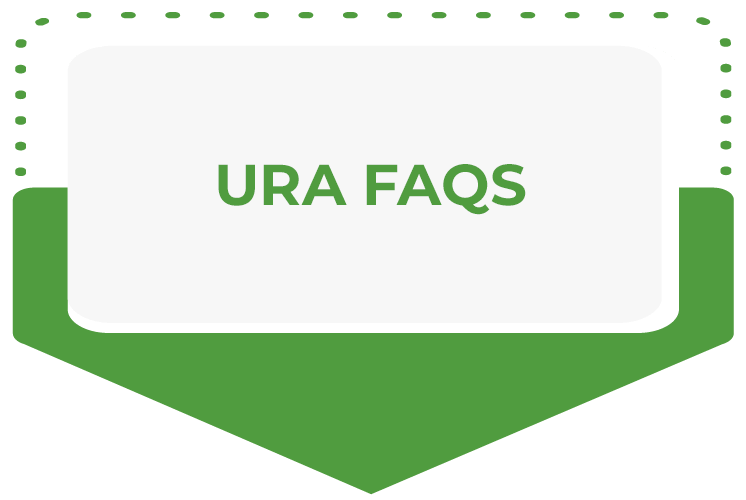This page contains information and resources regarding relocation and real property acquisition under the Uniform Relocation Assistance and Real Property Acquisition Policies Act of 1970, as amended (more commonly known as URA) and Section 104(d) of the Housing and Community Development Act of 1992, as amended (Section 104(d)). The information and resources here are provided by the Puerto Rico Department of Housing for CDBG-DR and CDBG-MIT funded programs. Click on the boxes below to access additional information and downloadable resources.
The URA and Section 104(d), except where waivers or alternative requirements have been provided by the U.S. Department of Housing and Urban Development (HUD) together establish relocation and real property acquisition requirements applicable to all federally funded programs and projects, which require the acquisition of real property and/or cause the displacement of persons from their homes, businesses and farms. The primary purpose of these laws and regulations is to provide uniform, fair, and equitable treatment of persons whose real property is acquired or who are displaced in connection with federally funded projects.
RELOCATION ASSISTANCE
When a household or business must relocate due to a federally funded project, they may be eligible for URA relocation assistance. The types and amounts of assistance that will be made available to displaced persons will depend on whether the displaced occupant is residential or non-residential, and whether it will be a temporary relocation (less than one (1) year) or permanent relocation.
Temporary Relocation

Permanent Relocation


The URA-ADP Guide contains guidelines and requirements for PRDOH and its subrecipients regarding URA requirements for CDBG-DR and CDBG-MIT funded programs. It also includes the PRDOH Anti-Displacement Plan which outlines the strategies established to minimize displacement caused by activities funded by these programs.
![]()
REGULATIONS
Section 104(d) regulations:
HUD Tenant Assistance, Relocation and Real Property Acquisition Handbook 1378:
![]()
ADDITIONAL TRAININGS
Consolidated Notice: URA, 104(d) and CDBG related requirements webinar:
![]()
EDUCATIONAL VIDEOS
URA Overview:
Section 104(d) Overview:
CDBG-DR Overview:

URA NOTIFICATION TEMPLATES
These templates are available to be utilized by Subrecipients and Contractors in the event of an acquisition or relocation activity. These templates will provide required information to property owners and tenants regarding their rights, protections, and eligibility for relocation assistance and payments under the URA.
REAL PROPERTY ACQUISITION
Whenever real property needs to be acquired for a federally funded project, URA acquisition requirements will apply. This includes real property that was acquired with non-federal funds but with the intent to use that property for a federally funded project.
There are two types of real property acquisition:
INVOLUNTARY
Involuntary acquisition uses the threat of eminent domain by an acquiring entity with such powers when first approaching the property owner. This type of acquisition is only appropriate when the property will be used for a public use. If the acquiring entity and owner cannot negotiate a sales agreement, then the entity may pursue with eminent domain proceedings to take the real property.
VOLUNTARY
Voluntary acquisition does not use the threat of eminent domain by the acquiring entity. The acquiring entity must inform the property owner up front that it is interested in acquiring their property, what it believes is fair market value, whether or not the entity has the power of eminent domain, and that it will not use its power of eminent domain should they fail to find agreement. If there is no agreement, the acquiring entity must walk away from the acquisition. Entities without the power of eminent domain will always acquire real property through voluntary acquisition.
Subrecipients and project owners must complete the applicable URA Compliance Checklists (link to this area of webpage) for any parcel of real property acquired or to be acquired for a CDBG-DR funded project. Before completing these checklists, the following questions need to be answered about the project which will inform whether it will be an involuntary or voluntary acquisition:
IS THE PROJECT
A PUBLIC USE?
A public use typically includes public facilities, roads, sidewalks, and other infrastructure that provides a broad benefit to everyone in an area or serves a common-carrier function. It does not include housing, and under CDBG-DR does not include economic development activities that primarily benefit private entities.
IS THE PROJECT
SITE-SPECIFIC?
Is the project’s feasibility dependent on acquiring specific parcels of property (like a road widening or expansion of a public square), or can the project be executed on other available properties? Is the project part of “an intended, planned, or designated project area” described at 49 C.F.R. § 24.101(b)(1)? The answers to these questions will further inform whether involuntary or voluntary acquisition is the appropriate method to use.

URA COMPLIANCE CHECKLISTS
PRDOH has established URA compliance checklists to be used by any subrecipient or project owner where any acquisition is required or when the project site, whether it is to be acquired or is already owned by the subrecipient or project owner, is occupied by residential or commercial tenants. With the exception of Checklist #4, an applicable checklist should be completed for each parcel to be acquired.
Checklist #1 Notifications to Owners and Tenants
Applies to any project that involves real property acquisition or a project site that is occupied with residential or commercial tenants.
Checklist #2 Appraisal of Real Property to be Acquired
Applies to any project that involves real property acquisition, except in certain instances where property is donated, and the donor waives the appraisal requirement.
Checklist #4 Relocation Plan
Applies to any project, with or without acquisition, where the project site is occupied by residential or commercial tenants. Only one of these Checklists is required for the project as a whole.
Checklist #4-A One-For-One Replacement
The Subrecipient must complete one checklist per residential unit demolished and/or converted, due to program funded activities. Ensure that supporting documentation has been attached to demonstrate each checklist item has been completed.
Checklist #5 Negotiations for URA Acquisitions
Applies to any project that involves real property acquisition.
- The Property Owner Conflict of Interest form must be completed by each property owner.
Checklist #6 Invoicing for Acquisitions
Applies to any project that involves real property acquisition; confirms the completion of previous applicable Checklists, completion of an environmental review, and informs the subrecipient on what documentation needs to be submitted to PRDOH for real property acquisition invoicing.
- The Funds Request for Real Property Acquisition Memorandum must be completed for each property to be acquired.

URA CLAIM FORMS & HUD BROCHURES
Any displaced person is entitled to a payment for moving and related expenses as the Agency determines to be reasonable and necessary.
Residential
HUD Brochure Relocation Assistance to Persons Displaced from their Homes (Section104(d)) (HUD-1365-CPD)
Selection of the Most Representative Comparable Replacement Dwelling for Computing a Replacement Housing Payment (HUD Form 40061)
Nonresidential
Claim for Fixed Payment in Lieu of Payment for Actual Nonresidential Moving and Related Expenses (HUD-40056)
HUD Brochure Relocation Assistance to Displaced Businesses, Nonprofit Organizations and Farms (HUD-1043-CPD)












